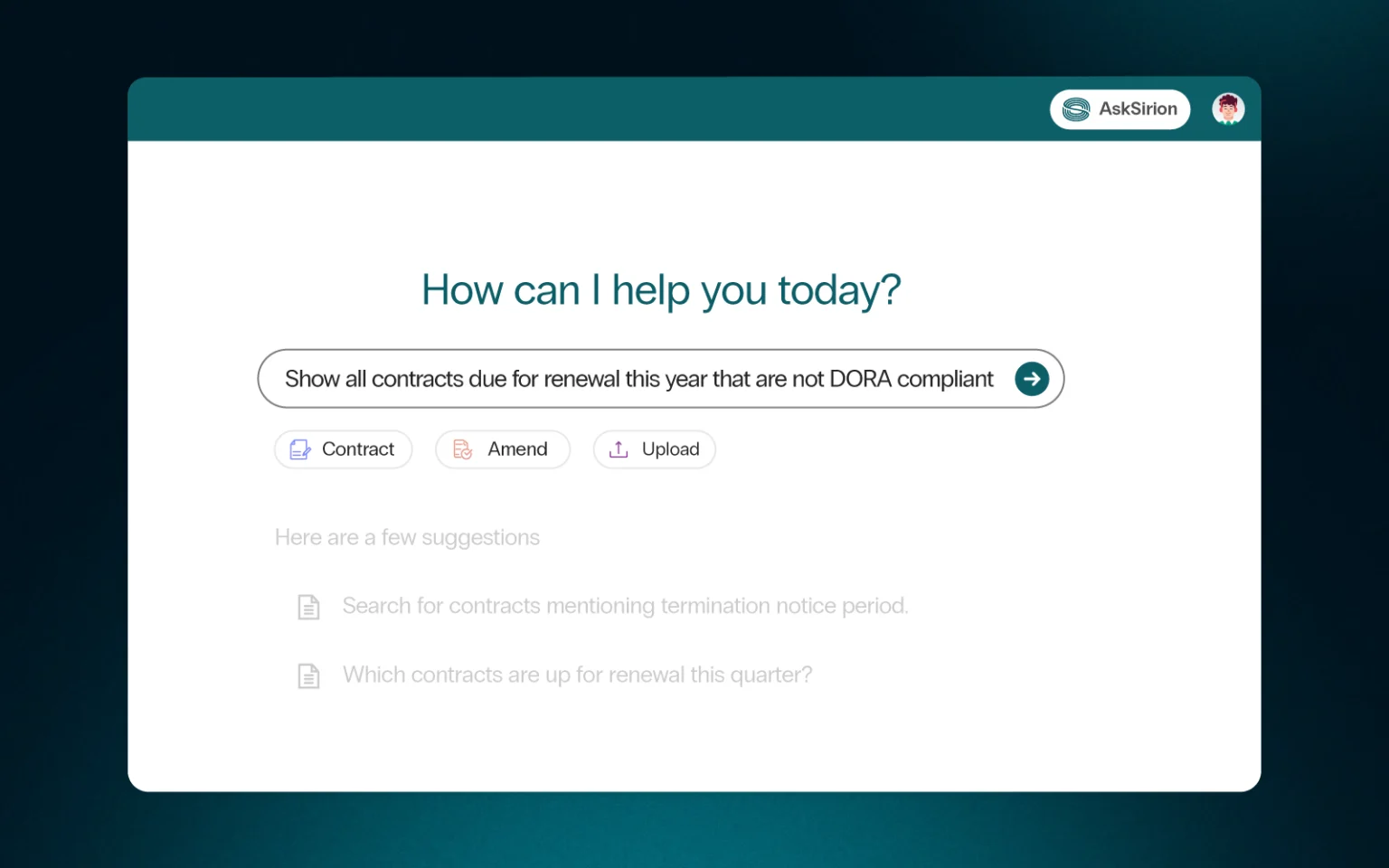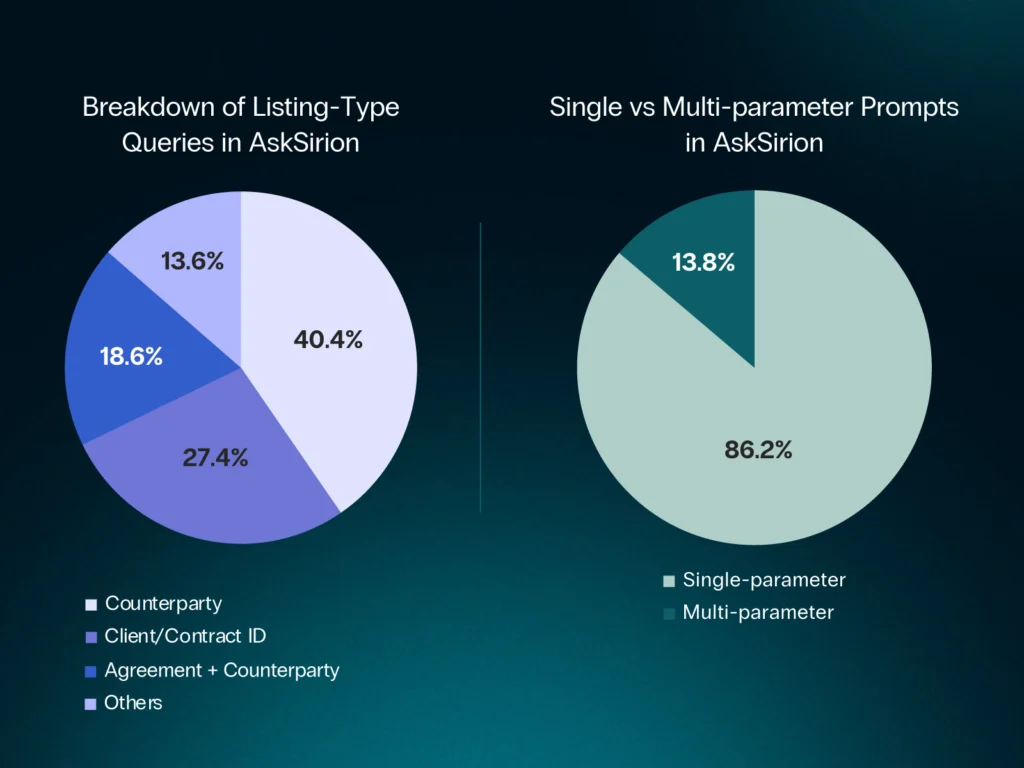How AskSirion is Doing for CLM What LLMs Did for Search

- Last Updated: Nov 17, 2025
- 15 min read
- SIRION
Remember when you had to open Google, type in keywords, and sift through pages of results? Today, you can ask Alexa a question while driving, chat with ChatGPT about complex problems, or get instant answers without ever opening a browser. This shift fundamentally changed how we expect to interact with information.
This isn’t entirely new, we’ve been moving toward conversational interfaces for years. Those chatbots that pop up on websites? They exist because people instinctively prefer asking questions in natural language over learning complex interfaces. The difference is that LLMs finally made these conversations actually work, transforming clunky, scripted interactions into meaningful dialogue.
Yet in contract lifecycle management, we’re still stuck in the pre-LLM era. Most CLM systems require users to log into specialized platforms, navigate complex interfaces, and translate natural business questions into system-friendly filters. The transformation happening now is the same one that revolutionized search: eliminating the friction between having a question and getting the answer.
What AskSirion Represents: Natural Language for Contract Intelligence
This is where AskSirion comes in. It’s Sirion’s natural language interface that lets you query your contract portfolio the same way you’d ask a colleague a question. Instead of needing to understand the underlying data schema or remembering whether “counterparty” is filed under “vendor” or “client,” you simply ask: “Show me all Microsoft contracts expiring in Q2 that have auto-renewal clauses.” The system handles the translation from your business question to the database structure automatically, eliminating the need to think like a database administrator.
This fundamentally changes how organizations interact with contract data. When you can ask complex, multi-layered questions in plain English and get immediate, visual responses with real-time charts and filtering, you eliminate the time spent navigating systems and focus on strategic analysis instead.
This matters because business professionals across departments think in terms of business logic, not database queries. Instead of wondering about “contract_status = active AND counterparty_type = vendor,” they think “Show me active contracts with Intellectual property clauses”. AskSirion translates natural business questions into system queries automatically, making contract intelligence accessible not just to legal teams, but to procurement, finance, and other business teams who need contract insights but lack specialized CLM training.
What Legal Teams Are Actually Asking: The Data Tells the Story
To understand whether this transformation is actually happening, we analyzed a sample of the real queries submitted through AskSirion. Each query was categorized into specific topic buckets to understand what the customers were asking from the platform.
The results provide clear insights into how legal professionals naturally interact with contracts when freed from traditional interface constraints.
Contract Filtering is the Primary Use Case: Most queries (93%) focus on listing and filtering contract subsets rather than retrieving individual documents. Common patterns include “List the contracts that are active and about to expire this quarter” and “Find all SOWs with Pepsico for the United States.” This indicates users are looking for efficient ways to narrow down large contract sets to find what they need.
Targeted Search with Known Business Attributes: Most queries reference known business attributes, with counterparty name searches accounting for about 40% of all listing queries. Users combine counterparty names, contract types, dates, and status indicators in targeted searches like “List the draft requests with Marriott that are on third party paper in signature phase.” This behavior suggests that the main priority for users is efficient access to specific information.
Growing Comfort with Complex Queries: Multi-parameter requests are a small but growing segment (~14%). Examples include “List the renewal dates for the contracts with TCV > 10 Mn$” and “List the contracts with termination and termination assistance clause.” These complex queries would have required multiple system interactions in traditional CLM platforms, showing that users are comfortable asking more sophisticated questions when the technology supports it.
Document-Level Intelligence Emerging:
There is a growing trend where users are interacting directly with documents, asking questions like “Does the Limitation of Liability clause cover confidentiality?” and “Who owns the IP to the deliverables created in this contract?” This marks a key shift in the overall journey. Users typically start by filtering for a list of relevant contracts and then take it a step further by diving into specific documents to ask detailed questions.
This trend is further validated by the fact that the broader platform ecosystem receives a significant number of document-specific queries annually, with queries related to contract identification, termination and renewal, and financial and payment terms together accounting for approximately 50% of all such questions.

The Implications: This Changes Everything About CLM Adoption
Clear user intent: The query patterns show users aren’t spending time exploring or learning the system; they arrive on the platform with specific business objectives and want the platform to help them achieve those results immediately.
Sophisticated search patterns: This confirms that system interfaces were the bottleneck limiting legal professionals’ contract analysis capabilities. When interfaces are intuitive, users naturally gravitate toward more specific, multi-parameter searches.
These usage patterns point to the next evolution: automated workflows. When users consistently search for similar combinations like party, status, and expiry dates, those patterns can be converted into proactive alerts and automated processes.
The implications extend beyond search efficiency. These usage patterns reveal that legal teams are ready for far more sophisticated contract technology than most CLM systems currently provide.
The Writing on the Wall: Natural Language is Now the Baseline
Users have moved past traditional search methods and now expect conversational contract interaction. The usage data demonstrates that legal professionals arrive with specific intent, combine multiple business attributes in single queries, and show comfort with sophisticated requests that traditional systems couldn’t handle efficiently.
These patterns suggest we’re at an inflection point in contract management. The question isn’t whether natural language interfaces will become standard, but how quickly legal teams will embrace tools that match how they naturally want to work.
The data confirms what many of us suspected that the barrier to sophisticated contract analysis was interface design, not professional capability. When that barrier is removed, legal teams can focus on strategic analysis rather than system navigation.

